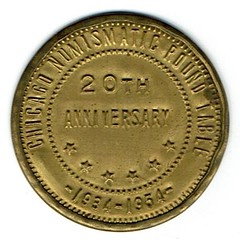
PREV ARTICLE
NEXT ARTICLE
FULL ISSUE
PREV FULL ISSUE
NOTES FROM E-SYLUM READERS: FEBRUARY 3, 2019How many shillings were too many? The "d" in £sd is from the Latin denarius, as the writer says, and the crossed L (£) is from Libra, or "a pound weight" in Latin. What's often overlooked is that the "s" is also Latin - from "solidus", not "shilling". Something I spotted only recently is that the typographical term for a "slash" (/) is also "solidus". I assume it isn't just coincidence that a "slash" or "solidus" was also used as the marker between the number of shillings and the number of pence (e.g. 4/5 or 4/5d as in the referenced article - 4 solidi and 5 denarii, so to speak!). The £sd system with its 20/12/1 ratios also existed in France and Italy until the 18th-19th centuries (Livre/sol/denier and Lira/soldo/denaro, respectively - also linguistic descendants of the three Latin names above). £ was still an abbreviation for "lira" until the introduction of the Euro. And sous (i.e. sols) and soldi are still current slang for "cash" in both languages, or were when I was there in the late 1980s. And now to my question(s). We know that 20 shillings made a pound - yet if you look in price lists published in Britain prior to 1971 (in old coin magazines, for example!), you'll find prices expressed in shillings to values much higher than 20 - e.g. 60, 70, 95, and sometimes more than 100. Now 100 shillings was 5 pounds, so why didn't they just say that? Or was it a carry-over from very early days when the shilling was the chief unit and the pound really only a unit of account? Something I've asked in various places before without getting a satisfactory answer - or indeed, any answer - is, what was the maximum value ever expressed in shillings in this way; or perhaps more simply, what was considered the cut-off point for pricing things in shillings, beyond which you would be expected to include the "pounds" in the price too? Thanks for the lesson and great question. I hadn't noticed that. Can anyone explain this for us? -Editor To read the earlier E-Sylum article, see: Rackus Encased Stamp   Pete Smith writes: The January 27 issue of The E-Sylum included the announcement that Dr. Alexander Rackus was named to the Chicago Numismatic Society Hall of Fame. Perhaps readers would be interested in a 38 mm encased stamp issued for Rackus. The obverse includes a stamp with a photo of Rackus. Text is off both sides and includes just part of his name. I have not figured out the source of this stamp. The reverse is embossed with the legend "CHICAGO NUMISMATC ROUND TABLE / 20 TH / ANNIVERSARY / * * * * * * / 1934-1954." The Heritage auction of March 22, 2016, included lot 84140 with the same brass shell but with a Statue of Liberty 3 cent stamp. It sold for $30. Other stamps are also reported in the same encasement. I attended the national token show in Omaha in 2007. A dealer learned of my interest in personal tokens and offered me three examples of the Rackus piece. I have not seen another example. Thanks, Pete. -Editor To read the earlier E-Sylum article, see: R.B. White Vatican Collection Manuscript I read your recent item on the R.B. White Chinese copper coin collection by Bruce W. Smith with much interest. Sometime in early 1976 I probably read a Coin World item about Mr. White looking for buyers of his three volume set of boxed books before he had the very fragile manuscript photocopied and bound. When I learned it had Vietnamese cash coins and amulets in it, I wrote to him that I would be a buyer but I would have to make payments to him. At that time I was on active duty and had a very low numismatic budget because Phung and I were still saving and investing most of our salaries to create the wealth we wanted for our future retirement. He sent me a memo (attached) where he wrote that my payments were acceptable to him and I would receive the 10th copy (the last copy available for sale). I was VERY happy. I had also written to him that I was working on a catalog about the coins and ingots of the Vietnamese kings and emperors and he wrote that he wanted a copy of it. I have been adding images and information for it since that time and have not yet published it but I am now very close. My problem was having the confidence to identify the authentic pieces versus the many, many replicas in the numismatic marketplace. I think I had only 10 people interested in it at that time but now it is several hundred, and I now have that confidence I needed before publishing it. I still have Mr. White's three volumes boxed set and it is one of the most significant references in my personal library. Besides the attached memo, I have two more pieces of correspondence from him. After I learned the American Numismatic Society was interested in saving the correspondence of significant numismatists, I added Mr. White's correspondence to a small stack of correspondence that will be donated to them.  Thanks, Howard. We'll look forward to your book! -Editor To read the earlier E-Sylum article, see:  Wayne Homren, Editor The Numismatic Bibliomania Society is a non-profit organization promoting numismatic literature. See our web site at coinbooks.org. To submit items for publication in The E-Sylum, write to the Editor at this address: whomren@gmail.com To subscribe go to: https://my.binhost.com/lists/listinfo/esylum All Rights Reserved. NBS Home Page Contact the NBS webmaster 
|